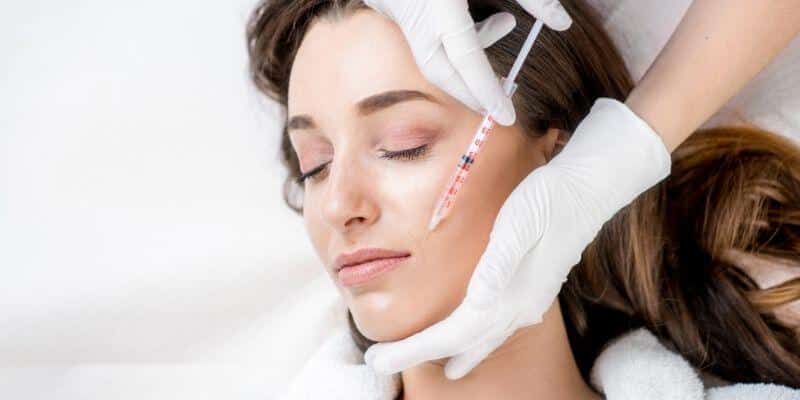
It’s a harsh reality we’re all aware of – wrinkles and folds can appear in many different facial locations, lengths and severity. These lines are commonly due to aging and environmental damage, but the good news is, they can be addressed with the use of dermal fillers. There’s a wide variety of dermal fillers available – let’s take a look at some together.
What are Dermal Fillers?
Injectable dermal fillers are designed to address and rejuvenate facial lines and wrinkles. Some fillers, like Juvederm Voluma, are known as volume fillers, and are designed to augment areas of soft tissue loss – helping the face to be contoured, rather than simply replacing lost volume within recessed scars, lines and wrinkles.
Sometimes it’s a challenge for patients to select between any number of these products, for a variety of reasons. Not only does the duration of effect vary between different products but the volume of each syringe, the side effects as well as product costs can sometimes make the final decision for the patient somewhat difficult.
Differences Between Fillers
In general, dermal fillers are designed to be injected at different levels into the dermis and subcutaneous tissue layers. But are there fillers designed for the lips? Absolutely. Lip augmentation or enhancement is achieved utilizing various dermal fillers, which are specially designed for the ultra-thin skin found on the lips.
Hyaluronic Acid Filler Longevity
Many fillers today are based around hyaluronic acid (HA), a substance that is naturally produced by the body, and plays an important role in providing firmness to the skin. But across all HA products, there are differences within each product line in terms of molecular size and shape and also the degree of cross linkage. It is these structural differences which make the various fillers amenable to treating either fine superficial lines or the deeper grooves of advanced aging and skin damage.
Note that HA dermal fillers are not permanent. Although the average duration of effect is 3 months, this time frame can be shorter or longer. Research has identified that the more an anatomical area moves, the shorter the duration of product. This is one of the main reasons why injection into the lip and nasolabial folds (which move near-constantly when we are awake and socializing) often last less time than when injected into static areas of the face.
Individuals who are facing the results of the natural aging process now have more options than ever when it comes to reducing the appearance of unwanted wrinkles and creases. Two of the most popular of the dermal fillers currently available today are Juvederm and Restylane. Although Juvederm and Restylane share some of the same benefits, they do have a few differences and those considering filler injections should consult with a skilled practitioner to learn which treatment might be best for them.
Juvederm vs. Restylane
Both Juvederm and Restylane are FDA approved and aid in restoring the skin’s natural youthfulness and overall vital look and feel. Depending upon personal preference, current facial condition, and your desired results, Juvederm and Restylane can both be effective treatments for patients 35 – 60 years of age.
Similarities
- Both fillers are made from hyaluronic acid, a naturally occurring substance that helps to attract water and hydrate the skin, adding rejuvenating volume to the skin.
- Each is highly effective for smoothing wrinkles, sculpting lips, and improving other facial features
- Both are administered with a minimally invasive treatment, and require little-to-no recovery time
Differences
- Juvederm typically takes a maximum of 24 hours for recovery, while Restylane can take anywhere from two to three days for the initial swelling to go down
- Results for Juvederm are more likely to appear instantly while the results for Restylane won’t be as evident until roughly a week after the procedure
- The results of Juvederm typically lasts from three to nine months while results for Restylane can last for six months or more
Radiesse
In December 2006, the FDA approved Radiesse for the treatment of deep facial folds and wrinkles, in addition to augmenting and restoring areas of the face affected by fat loss. Radiesse, like other dermal fillers, is injected just beneath the surface of the skin to add volume to those unfortunate sunken areas, to enhance overall facial appearance. Significant results are typically visible after only one treatment, but additional treatments are often necessary for maintenance.
Radiesse contains particles of a synthetic substance known as calcium hydroxylapatite, suspended in an injectable gel. Calcium hydroxylapatite, although synthetic, is very similar to a substance found naturally in bones and has long been used in medical devices. It is extremely well-tolerated by the human body.
Ideal candidates for Radiesse include individuals with deep wrinkles and facial folds looking for smoother, younger-looking skin. Radiesse is also ideal for restoring facial fullness in patients with HIV who frequently suffer from lipidatrophy – a condition marked by hollows around the eyes and sunken cheeks.
Benefits of Radiesse include:
- Improved facial contouring
- Procedure is minimally invasive
- Immediate results
- Results generally lasting for at least one year
- Little or no downtime
Side effects are generally mild but may include redness, bruising, swelling, and the rare chance of infection.
The Radiesse Procedure
Radiesse is a synthetic solution consisting of a compound known as calcium hydroxylapatite (CaHA) – a compound similar to what’s found in our teeth and bones. The Radiesse injection procedure is a fast, and relatively painless one. Radiesse is injected into the skin in the target areas, where it then works to augment and add volume to the creased or depressed areas.
The Healing Process
After Radiesse injections, patients may experience mild swelling – which will typically subside within 24 hours of the procedure and with the help of ice. Mild bruising or small bruise spots may also temporarily appear in the area of the injections, but these will also heal within a short period of time. Once injected, Radiesse takes on the form of the tissue surrounding it and becomes fairly soft when it’s injected into fat tissue.
Results, however, are immediate and can last as long as nine months. Patients who receive Radiesse injections will walk away from the treatment procedure with a more youthful, healthy facial appearance.
Radiesse side effects
Researchers have yet to conclude if there are any severe Radiesse side effects. However, as with all cosmetic treatments, Radiesse injections do carry some minor risks. Some of the more common side effects include mild swelling and bruising surrounding the site of injection, which typically subsides after 24 hours with the help of ice.
The benefits of of this treatment typically outweigh any minimal side effects. The benefits include improved facial appearance and long-lasting results. In most instances, the benefits of Radiesse injections can be expected to last for up to nine months.
Wrapping Up
A great way to address the signs of aging is with dermal fillers. Whether it’s facial wrinkles, creases in the face, or lifeless lips, today’s dermal fillers can go a long way in rejuvenating your look, safely and effectively. Licensed medical practitioners can shop dermal fillers at Health Supplies Plus.

About the Author: Doris Dickson is a specialist writer for Health Supplies Plus, focusing on the aesthetic medicine industry. She diligently researches cosmetic treatments and products to provide clear, concise information relevant to licensed medical professionals. Her work supports Health Supplies Plus’s commitment to being a reliable informational resource and trusted supplier for the aesthetic community.
Disclaimer: The content provided in this article is intended for informational purposes only and is directed towards licensed medical professionals. It is not intended to be a substitute for professional medical advice, diagnosis, or treatment, nor does it constitute an endorsement of any specific product or technique. Practitioners must rely on their own professional judgment, clinical experience, and knowledge of patient needs, and should always consult the full product prescribing information and relevant clinical guidelines before use. Health Supplies Plus does not provide medical advice.

